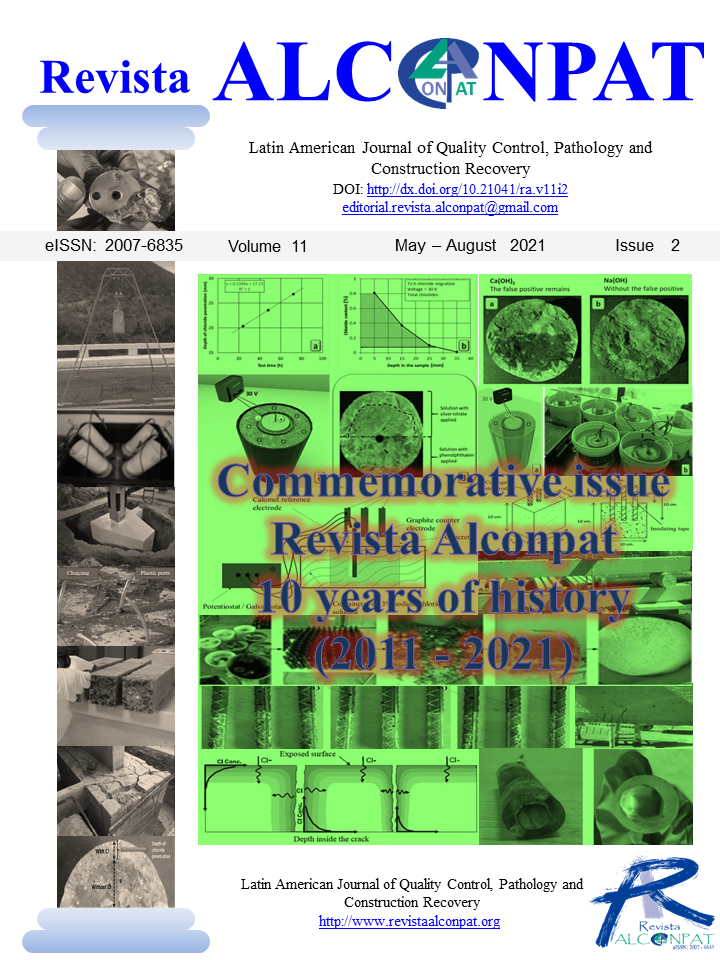Use of chitosan as an organic coating to prevent / inhibit the corrosion of reinforced concrete
DOI:
https://doi.org/10.21041/ra.v11i2.519Keywords:
corrosion, inhibitor, apple vinegar, concrete, chitosanAbstract
This work analyzes the performance of reinforced concrete (RC) against corrosion by applying a chitosan coating to the rebar. Specimens with different amounts of chitosan using solvents of apple vinegar, acetic acid and sugarcane alcohol vinegar were prepared and subjected to electrochemical polarization curves (PC), half-cell potential (HCP), electrochemical noise (EN) and linear polarization resistance (LPR) tests. The amount of chitosan and optimal layers (thickness) with an improvement in the protective properties was determined and low corrosion rates were obtained in the concrete exposed to chlorides for 200 days. The preservation of the coating on the steel in concrete turns out to be interesting for future studies.
Downloads
References
Aballe, A., Bautista, A., Bertocci, U., Huet., F. (2001),"Measurement of the Noise Resistance for Corrosion Applications", CORROSION. 57(1):35-42. https://doi.org/10.5006/1.3290327
Alonso, C., Andrade, C., Castellote, M., Castro, P. (2000), "Chloride threshold values to depassivate reinforcing bars embedded in a standardized OPC mortar", Cement and Concrete Research. 30:1047-1055. https://doi.org/10.1016/S0008-8846(00)00265-9
Anandhavelu, S., Dhanasekaran, V., Sethuraman, V., Park, H. J. (2017), "Chitin and Chitosan Based Hybrid Nanocomposites for Super Capacitor Applications", Journal of Nanoscience and Nanotechnology. 17:1321-1328. https://doi.org/10.1166/jnn.2017.12721
Andrade, C., Alonso, C. (1996), "Corrosion rate monitoring in the laboratory and on-site", Construction and Building Materials. 10:315-328. https://doi.org/10.1016/0950-0618(95)00044-5
Andrade, C., Martínez, I. (2010), "Techniques for measuring the corrosion rate (polarization resistance) and the corrosion potential of reinforced concrete structures", in: Non-Destructive Evaluation of Reinforced Concrete Structures. Elsevier W.P., cap. 14, pp. 284-316. https://doi.org/10.1533/9781845699604.2.284
Ashassi-Sorkhabi, H., Kazempour, A. (2020), "Chitosan, its derivatives and composites with superior potentials for the corrosion protection of steel alloys: A comprehensive review", Carbohydrate Polymers. 237:116110. https://doi.org/10.1016/j.carbpol.2020.116110
ASTM International (2003). ASTM C33-03, Standard Specification for Concrete Aggregates, ASTM International. https://doi.org/10.1520/C0033-03
ASTM International (2012). ASTM C31/C31M-12, Standard Practice for Making and Curing Concrete Test Specimens in the Field. https://doi.org/10.1520/C0031_C0031M-12
ASTM International (2014). ASTM C192/C192M-14, Standard Practice for Making and Curing Concrete Test Specimens in the Laboratory. https://doi.org/10.1520/C0192_C0192M-14
ASTM International (2014). ASTM G59-97, Standard Test Method for Conducting Potentiodynamic Polarization Resistance Measurements. https://doi.org/10.1520/G0059-97R14
ASTM International (2015). ASTM C876-15, Standard Test Method for Corrosion Potentials of Uncoated Reinforcing Steel in Concrete. https://doi.org/10.1520/C0876-15
ASTM International (2016). ASTM C109/C109M-16a, Standard Test Method for Compressive Strength of Hydraulic Cement Mortars (Using 2-in. or [50-mm] Cube Specimens). https://doi.org/10.1520/C0109_C0109M-16A
Aydin, F., Saribiyik, M. (2010), "Correlation between Schmidt Hammer and destructive compressions testing for concretes in existing buildings", Scientific Research and Essays. 5(13):1644-1648.
Bezerra, U. T. (2016), "Biopolymers with superplasticizer properties for concrete" in: Biopolymers and Biotech Admixtures for Eco-Efficient Construction Materials. Elsevier W.P., cap. 10, pp. 195-220. https://doi.org/10.1016/B978-0-08-100214-8.00010-5
Cano-Barrita, P. F. J., León-Martínez, F. M. (2016) "Biopolymers with viscosity-enhancing properties for concrete" in: Biopolymers and Biotech Admixtures for Eco-Efficient Construction Materials. Elsevier W.P., cap. 11, pp. 221-252. https://doi.org/10.1016/B978-0-08-100214-8.00011-7
Carneiro, J., Tedim, J., Fernandes, S. C. M., Freire, C. S. R., Gandini, A., Ferreira, M. G. S., Zheludkevich, M. L. (2013), "Functionalized chitosan-based coatings for active corrosion protection", Surface and Coatings Technology. 226:51-59. https://doi.org/10.1016/j.surfcoat.2013.03.035
Carneiro, J., Tedim, J., Ferreira, M. G. S. (2015), "Chitosan as a smart coating for corrosion protection of aluminum alloy 2024: A review", Progress in Organic Coatings. 89:348-356. https://doi.org/10.1016/j.porgcoat.2015.03.008
Castelló, M. E., Amalvy, J. I., Anbinder, P. S., Peruzzo, P. J. (2019) "Obtención Y Caracterización De Quitosano Y Películas Quitosano- Glicerol", 5o Jordanas ITE - Facultad de Ingeniería - UNPL. pp. 797-803.
Díaz-Blanco, Y. et al. (2019) "Effect of Recycled PET (Polyethylene Terephthalate) on the Electrochemical Properties of Rebar in Concrete", International Journal of Civil Engineering. 18:487-500. https://doi.org/0.1007/s40999-019-00478-3
Díaz Blanco, Y. et al. (2019) "Natural additive (nopal mucilage) on the electrochemical properties of concrete reinforcing steel", Revista ALCONPAT. 9(3):260-276. https://doi.org/10.21041/ra.v9i3.429
Dima, J. B., Zaritzky, N. E. (2019) "Quitosano obtenido de desechos de la industria pesquera y su aplicación como adsorbente de metales pesados", in: Perez, T. Los residuos que generamos. Su manejo sustentable, un gran desafío. Buenos Aires, ANCEFN, cap. 5, pp. 83-108.
Dodson, V. H. (1990) "Water reducing chemical admixtures introduction", in: Concrete Admixtures. Springer, cap. 3, pp. 39-71. https://doi.org/10.1007/978-1-4757-4843-7_3
Dodson, V., Hayden, T. (1989) "Another Look at the Portland Cement/Chemical Admixture Incompatibility Problem", Cement, Concrete and Aggregates. 11(1):52-56. https://doi.org/10.1520/CCA10102J
Feliu, S., González, J. A., Andrade, M. C., Feliu, V. (1989) "Determining polarization resistance in reinforced concrete slabs", Corrosion Science. 29(1):105-113. https://doi.org/10.1016/0010-938X(89)90083-8
Gacén, J., Gacén, I. (1996) "Quitina y quitosano. Nuevos materiales textiles", Boletin Intexter (U.P.C). 110:67-71.
Gebhardt, F., Seuss, S., Turhan M. C., Hornberger, H., Virtanen, S., Boccaccini, A. R. (2012) "Characterization of electrophoretic chitosan coatings on stainless steel", Materials Letters. 66:302-304. https://doi.org/10.1016/j.matlet.2011.08.088
Genesca, J., Meas, Y., Rodríguez, F. J., Mendoza, J., Durán, R., Uruchurtu, J., Malo, J. M., Martínez, E. A., Arganiz, C., Pérez, T., Martínez, A., Chacón, J. G., Goana, C., Almeraya, F. M., González, J. G. (2002), "Técnicas Electroquímicas para el Control y Estudio de la Corrosión". UNAM, D. F., México, p. 244.
Gholamhosseinzadeh, M. R., Aghaie, H., Shahidi Zandi, M., Giahi, M. (2019), "Rosuvastatin drug as a green and effective inhibitor for corrosion of mild steel in HCl and H2SO4 solutions", Journal of Materials Research and Technology. 8(6):5314-5324. https://doi.org/10.1016/j.jmrt.2019.08.052
Girija, S., Kamachi Mudali, U., Khatak, H. S., Baldev Raj (2007), "The application of electrochemical noise resistance to evaluate the corrosion resistance of AISI type 304 SS in nitric acid", Corrosion Science. 49(11):4051-4068. https://doi.org/10.1016/j.corsci.2007.04.007
Hansson, C. M. (1984), "Comments on electrochemical measurements of the rate of corrosion of steel in concrete", Cement and Concrete Research. 14(4):574-584. https://doi.org/10.1016/0008-8846(84)90135-2
Hernández Cocoletzi, H., Águila Almanza, E., Flores Agustin, O., Viveros Nava, E. L., Ramos Cassellis, E. (2009), "Obtención y caracterización de quitosano a partir de exoesqueletos de camarón", Superficies y Vacío. 22(3): 57-60.
Hernández, M., Genescá J., Uruchurtu, J., Barba, A. (2009), "Correlation between electrochemical impedance and noise measurements of waterborne coatings", Corrosion Science. 51:499-510. https://doi.org/10.1016/j.corsci.2008.12.011
Hostalet Alba, F. (1994), "Situación actual de las técnicas de ensayo no destructivo del hormigón", Informes de la Construcción. 46(433):19-31. https://doi.org/10.3989/ic.1994.v46.i433.1114
Knorr, D. (1991), "Recovery and Utilization of Chitin and Chitosan in Food Processing Waste Management", Food Technology, 45:114-122.
Mansfeld, F., Sun, Z., Hsu, C. H. (2001), "Electrochemical noise analysis (ENA) for active and passive systems in chloride media", Electrochimica Acta. 46:3651–3664. https://doi.org/10.1016/S0013-4686(01)00643-0
Martínez-Barrera, G., Vigueras-Santiago, E., Hernández-López, S., Martínez-Barrera, G., Brostow, W., Menchaca-Campos, C. (2005), "Mechanical improvement of concrete by irradiated polypropylene fibers", Polymer Engineering & Science. 45(10):1426-1431. doi: https://doi.org/10.1002/pen.20418
O Reilly, V. (2007), "Métodos para Dosificar Concretos de Elevado Desempeño". IMCYC, D.F., México, p. 207.
Pacheco, N. (2010), "Extracción biotecnológica de quitina para la producción de quitosanos: caracterización y aplicación", Food and Nutrition. Université Claude Bernard; Université au- tonome métropolitaine (Universidad Autónoma Metropolitana) (Iztapalapa), p. 124
Page, C. L., Treadaway, K. W. J., Bamforth, P. B. (1990), "Corrosion of reinforcement in concrete". Elsevier Applied Science, London-New York. p. 612.
Pakdel, P. M., Peighambardoust, S. J. (2018), "Review on recent progress in chitosan-based hydrogels for wastewater treatment application", Carbohydrate Polymers. 201:264-279. https://doi.org/10.1016/j.carbpol.2018.08.070
Papavinasam, S. (2008), "Electrochemical polarization techniques for corrosion monitoring", in: Yang, L. Techniques for Corrosion Monitoring. Elsevier W.P., cap. 3, pp. 49-85. https://doi.org/10.1533/9781845694050.1.49
Pech-Canul, M. A., Castro, P. (2002), "Corrosion measurements of steel reinforcement in concrete exposed to a tropical marine atmosphere", Cement and Concrete Research, 32(3): pp. 491-498. https://doi.org/10.1016/S0008-8846(01)00713-X.
Pérez-Quiroz, J. T., Terán, J., Herrera, M. J., Martínez, M., Genescá, J. (2008), "Assessment of stainless steel reinforcement for concrete structures rehabilitation", Journal of Constructional Steel Research. 64(11):1317-1324. https://doi.org/10.1016/j.jcsr.2008.07.024
Sanchez-Amaya, J. M., Cottis, R. A., Botana, F. J. (2005), "Shot noise and statistical parameters for the estimation of corrosion mechanisms", Corrosion Science. 47:3280-3299. https://doi.org/10.1016/j.corsci.2005.05.047
Shrinivas Rao, M., Aye Nyein, K., Si Trung, T., Stevens, W. F. (2007), "Optimum parameters for production of chitin and chitosan from squilla (S. empusa)", Journal of Applied Polymer Science. 103:3694-3700. https://doi.org/10.1002/app.24840
Sousa Andrade, V., de Barros Neto, B., Fukushima, K., de Campos-Takaki, G. M. (2003), "Effect of medium components and time of cultivation on chitin production by Mucor circinelloides (Mucor javanicus IFO 4570) - A factorial study", Revista Iberoamericana de Micologia. 20:149-153.
Stern, M., Geary, A. L. (1957), "Electrochemical Polarization I. A Theoretical Analysis of the Shape of Polarization Curves", Journal of The Electrochemical Society, 104(1):56-63. https://doi.org/10.1149/1.2428653
Taji, I., Ghorbani, S., de Brito, J., Tam, V. W. Y., Sharifi, S., Davoodi, A., Tavakkolizadeh, M. (2018), "Application of statistical analysis to evaluate the corrosion resistance of steel rebars embedded in concrete with marble and granite waste dust", Journal of Cleaner Production. 210:837-846. https://doi.org/10.1016/j.jclepro.2018.11.091
Taylor, H. F. W. (1990), "Cement Chemestry". Thomas Telford, London, p. 437.
Zhou, B., Gu, X., Guo, H., Zhang, W., Huang, Q. (2018), "Polarization behavior of activated reinforcing steel bars in concrete under chloride environments", Construction and Building Materials. 164:877-887. https://doi.org/10.1016/j.conbuildmat.2018.01.187
Zhou, S., Zhang, S., Shen, J., Guo, W. (2019), "Effect of cattle manure ash’s particle size on compression strength of concrete", Case Studies in Construction Materials. 10:e00215. https://doi.org/10.1016/j.cscm.2018.e00215
Downloads
Published
How to Cite
Issue
Section
License
_______________________________
License in effect from September 2020
You are free to:
- Share — copy and redistribute the material in any medium or format for any purpose, even commercially.
- Adapt — remix, transform, and build upon the material for any purpose, even commercially.
- The licensor cannot revoke these freedoms as long as you follow the license terms.
Under the following terms:
- Attribution — You must give appropriate credit , provide a link to the license, and indicate if changes were made . You may do so in any reasonable manner, but not in any way that suggests the licensor endorses you or your use.
- No additional restrictions — You may not apply legal terms or technological measures that legally restrict others from doing anything the license permits.
Notices:
You do not have to comply with the license for elements of the material in the public domain or where your use is permitted by an applicable exception or limitation .
No warranties are given. The license may not give you all of the permissions necessary for your intended use. For example, other rights such as publicity, privacy, or moral rights may limit how you use the material.





















.png)














